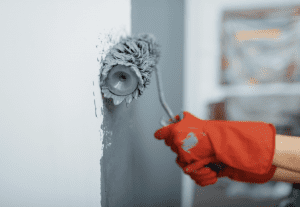
Painting Boston-area Assisted Living & Senior Communities: Process, paints and considerations
Posted on January 30, 2023
CertaPro works with dozens of area senior communities to make the process easy and safe:
Painting an assisted living community requires experience much beyond choosing a color. As a Massachusetts Assisted Living Association (Mass-ALA) member, we care about understanding the unique challenges of facility managers in assisted living communities to better plan the painting projects around what’s most important to your community.
Our painting teams address the following issues that are important to assisted living communities when they’re painting:
- Safety of residents includes:
- Ensuring doors are locked
- Reinstalling grab bars before we let residents back into an area.
- Wearing face masks.
- Front doors stay locked and are not propped open.
- The areas where we’re working are sectioned off and cannot be accessed by residents accidentally.
- Re-routing residents to an alternative route while we’re working
- Timing the painting – we understand the 24/7 nature of senior communities and will plan our work when areas are not in use.
- Large and small projects – we understand that facility managers often have tiny painting projects that they can’t find anyone else to do, so we can handle anything from painting a resident’s room to the entire exterior of the community.
- Painting products designed for communities – including scuff-resistant paint in high-traffic areas and germ-killing paint in areas requiring extra sanitation.
- Color selection – our free designer can work with you or your residents to ensure the community is warm and inviting without confusing residents by changing colors.
- Night and weekend painting – we can work when your residents are sleeping at no extra charge.

For senior communities: “The process is as important as painting.”
Painting within an assisted living community affects the lives of staff, facility managers, and hundreds of residents, so coordinating interior and exterior painting without disrupting the activities of the residents and staff requires precision and collaboration.
Our painting projects in occupied assisted living facilities require detailed upfront planning. We understand that these communities are 24-hour-a-day operational establishments. Because there is no “downtime,” we plan a strategy with the facility manager to plan and schedule the painting process before our painters pick up a paintbrush.
Communication is also essential to ensure all community members are on board and know what to expect. This can mean many things, including signage, emails, and getting the staff and residents on board with how the project will flow. It also means strict timelines so daily activities are not disrupted.
We encourage the facility manager to ask staff when it is most convenient for our painters to be in each area of the assisted living community to provide ample time for necessary changes to schedules, processes, and painting tasks. When we combine the knowledge of the facility managers, and staff, with our painters, we have the most success.
For example, if painting is needed near the dining room, dust and noise are minimized, and our crews can work late nights in that area to ensure food can be served on time.
We brief all our painters with pre-project training to ensure the working hours are enforced, talking is kept to a minimum, and residents’ privacy is respected.

Safety of the residents and workers:
We can use non-toxic, non-VOC paints to ensure minimal paint fumes for residents with respiratory issues. These paints off-gas very few paint fumes so the smell of the new paint doesn’t interfere with the taste of the food in the dining areas.
We know that any grab bars and non-skid stair treads that are removed must be replaced before the residents re-enter the area.
We also take extra care to ensure the areas we paint are marked and/or blocked off to prevent residents from falling.
In memory care communities, we ensure that doors that need to stay shut stay shut.
If residents have mobility issues, we consider how they can access the areas where we are painting. We often suggest detours to allow residents to remain mobile while the project is happening.
Our safety certifications include:
- OSHA certified
- EPA lead-certified
- All of our licenses and certifications are here.
Minimal disruptions
Understanding that residents follow a strict routine, we can work with their schedule to paint.
We keep the work areas tidy and clean up quickly so we are not in the way when the residents pass to and from their activities and meals.
One call to CertaPro for all of your Interior & Exterior painting and carpentry:

Whether your assisted living community is an assisted living facility or a CCRC (Continuing Care Retirement Community) with skilled nursing and independent living also on your campus, we can help get your interior and exterior painting completed safely for the residents.
We can work around sensitive medical equipment for long-term care (LTC) community residents.
Even if residents live independently, we can coordinate directly with them to complete the project. If a ceiling needs painting because of a leak, we’ll handle that project while ensuring the resident is not inconvenienced.
Our carpenters can handle wood replacement before painting on exterior trim areas, clapboards, shingles, windows, and decks.
Small and large projects alike:
Once an assisted living community chooses us to paint for them, they call us for large and small projects. We can paint single interior rooms or the entire exterior of your community.
When your residents want their room painted – no problem.
This means that you no longer have to worry that a project is “too small” to call us – we handle single rooms with the same urgency as large projects because we understand you may need to quickly turn over the room to a new resident or have a resident who just wants a fresher look in their space.
Residents are welcome to work with our free designer to choose paint colors that ensure their space feels like home and differs from the apartment across the hallway.
We understand that there may be times when a resident’s family wants to decorate before a senior moving in. We can accommodate this timeline and ensure the couch from home looks great with the paint color.
We can also bill residents directly for the painting.
Regular touch-ups:
We can also handle regular paint touch-ups to keep your community looking fresh and modern without the expense of a full repaint.
We can also handle large projects like exterior repaints and interior painting after a large renovation.

Painting at night:
So your activities are not disrupted in your assisted living community during the day, our crews can work at night in common areas when assisted living facility residents sleep.
If we have to work in individual residents’ rooms or units, our crews ensure the resident can first attend to their ADLs (activities of daily living) before we enter the space to paint. This means we can start our painting later in the morning to give the residents plenty of time.
Germ-killing paint keeps germs from spreading:
We specify microbicidal paint in lobbies, bathrooms, and common areas to keep germs from spreading.
This paint kills germs for about three years and ensures you are not constantly cleaning the walls to get rid of germs.
Scuff-resistant paint for high-traffic areas:
In areas that need extra durability against dings and scratches, we often specify scuff-resistant paint that is so durable it’s used to paint hockey rinks. This means when walkers, wheelchairs, canes, etc. bump up against the scuff-resistant paint, no marks or scuff will occur.

And, of course, color can make all the difference:
Our designer Kate can help you choose new colors or freshen up the old ones. Color consultation is free for all assisted living communities working with us because color can provide the feeling you want your spaces to have. Kate will offer her expertise in deciding colors for different areas.
For example, for residents with cognitive impairment choosing a color that’s soothing and familiar might help residents feel more comfortable.
On the other hand, brighter and bolder colors in high-activity areas might make the space even more vibrant.
In memory care communities, painting the resident room doors different colors is a way to allow residents to find their rooms more easily. This also can be helpful in non-memory settings as seniors with vision issues can clearly find their door.
Color can also aid in way-finding for residents. Community members might know to follow the yellow hallways to get around, and we wouldn’t want to disturb that by painting that hallway a new color.
Especially in memory care communities, brighter colors tend to help with the mood and behavior of residents. Keeping the colors light and bright with as much sunlight reflecting through the windows can aid with sundowning and agitation.
Enhancing window trim and sills with fresh paint ensures that curtains are drawn daily and residents can connect to the outdoors – something important to their well-being if they can’t easily get outside – especially in the winter in our cold Boston climate.
The right color can also help your community look cleaner. We consider the lighting when suggesting color, and often, for example, the change from warm white to cool white makes the whole space look fresh and modern.
Time and time again, we’ve been able to add just the “right color” to help deinstitutionalize the environment and create a warm and homey area.
Resident input on color schemes:
Getting input from the residents is a great way to build community – after all, this is their home. They may prefer colors or designs to help make the community feel more like home.
Reasons Your Senior Community Needs Painting:
Break Down of Exterior Surfaces. If peeling, fading or cracking paint is left alone, it could lead to water infiltration, mold growth, or pest infestations. When water gets inside wood, it rots causing costly repairs.
Water Stains. Staining to ceilings and walls is unsightly and could hurt the sales department’s ability to sell units to new residents.
Corporate color changes may force some interior and exterior areas to need changing.
Increase Community’s Lifespan. A well-maintained community can last for many years. Keeping up with the upkeep in the community can help increase its lifespan by protecting it from interior and exterior wear and tear.
Case Study Examples of Work We’ve Done in Boston-area Senior Communities:
- Kingston, Massachusetts: the community has us paint resident rooms each time a new resident moves in. This is done on-call, and we usually turn over the project within a week.
- South Shore community had us repaint all public bathrooms using germ-resistant paint.
- Another South Shore community had us replace wood railings on their residents’ decks and restain them.
- South Shore community had the entire exterior painted.
- Boston community had parking lot bollards painted.
- Maintenance and long-term Support of communities throughout Boston and the South Shore that call us for ongoing maintenance services such as regular paint touch-ups, carpentry needs, painting after a leak, and resident move-in projects.
If you have any questions about working with us to paint your assisted living community, email Dave at [email protected] or call him at (781) 422-1018. We’re happy to answer your questions even if you don’t have a painting project.







